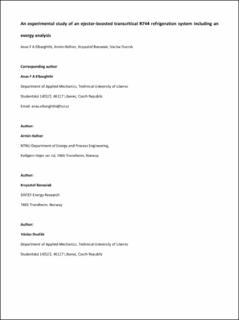| dc.contributor.author | Elbarghthi, Anas F.A. | |
| dc.contributor.author | Hafner, Armin | |
| dc.contributor.author | Banasiak, Krzysztof | |
| dc.contributor.author | Dvorak, Vaclav | |
| dc.date.accessioned | 2021-10-25T11:17:30Z | |
| dc.date.available | 2021-10-25T11:17:30Z | |
| dc.date.created | 2021-05-10T12:21:15Z | |
| dc.date.issued | 2021 | |
| dc.identifier.citation | Energy Conversion and Management. 2021, 238, . | en_US |
| dc.identifier.issn | 0196-8904 | |
| dc.identifier.uri | https://hdl.handle.net/11250/2825321 | |
| dc.description.abstract | The field of refrigeration witness a massive transition in the supermarket with a strong focus reflected on energy consumption. The use of ejector allows for overcoming the significant exergy destruction lays on the expansion processes of the cooling systems and led to spark improvement in the system performance by recovering some of the expansion work. In this study, a detailed experimental work and exergy analysis on the R744 transcritical ejector cooling system was investigated. The experiment was implemented on the commercial ejector cartridge type (032F7045 CTM ELP60 by Danfoss). The impact of different operating conditions determined by exit gas cooler pressure and temperature, evaporation temperature and receiver pressure was examined. The ejector performance of the pressure lift, mass entrainment ratio, work rate recovery and efficiency were evaluated. In addition, exergy efficiency and the variation of exergy produced, consumed, and destruction were assessed based on the transiting exergy. The result revealed better overall performance when the ejector operated at transcritical conditions. The ejector was able to recover up to 36.9% of the available work rate and provide a maximum pressure lift of 9.51 bar. Moreover, it was found out that the overall available work recovery potential increased by rising the gas cooler pressure. Out of the findings, the ejector could deliver maximum exergy efficiency of 23% when working at higher motive nozzle flow temperatures along with providing lower exergy destruction. The experiment results show that the amount of the exergy consumed and destruction were gradually increased with higher gas cooler pressure and, in contrast, decreasing with higher motive nozzle flow temperature. © 2021 Elsevier Ltd | en_US |
| dc.language.iso | eng | en_US |
| dc.publisher | Elsevier Science | en_US |
| dc.rights | Attribution-NonCommercial-NoDerivatives 4.0 Internasjonal | * |
| dc.rights.uri | http://creativecommons.org/licenses/by-nc-nd/4.0/deed.no | * |
| dc.title | An experimental study of an ejector-boosted transcritical R744 refrigeration system including an exergy analysis | en_US |
| dc.type | Peer reviewed | en_US |
| dc.type | Journal article | en_US |
| dc.description.version | acceptedVersion | en_US |
| dc.source.volume | 238 | en_US |
| dc.source.journal | Energy Conversion and Management | en_US |
| dc.identifier.doi | 10.1016/j.enconman.2021.114102 | |
| dc.identifier.cristin | 1909147 | |
| dc.relation.project | Norges forskningsråd: 294662 | en_US |
| dc.description.localcode | This is the authors' accepted manuscript to an article published by Elsevier. Locked until 23 April 2023 due to copyright restrictions. The AAM is made available under the CC-BY-NC-ND 4.0 license http://creativecommons.org/licenses/by-nc-nd/4.0/ | en_US |
| dc.source.articlenumber | 114102 | en_US |
| cristin.ispublished | true | |
| cristin.fulltext | postprint | |
| cristin.qualitycode | 1 | |

